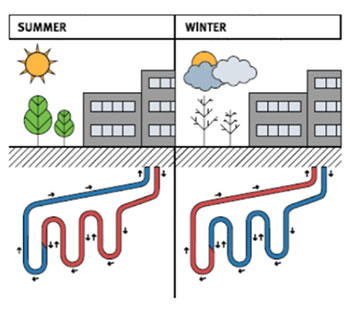What is a Geothermal Heat Exchange?
This part of the Living Lab trail features CLC's geofield, the heart of a geothermal heat exchange system that heats and cools the core buildings on campus. This system condenses and transfers heat between the buildings and the earth deep underground. Students in the HVAC, Engineering Technology and Geology programs observe this living lab to learn how these systems function. This experience gives them an edge when competing for jobs such as professional engineers and system programmers.

How does a Geofield work?
The wells in the geofield are 500 feet deep where the temperature of the earth’s crust in this region is always 55 degrees. This makes the system effective and reliable, because that temperature is warmer than the outside air in the winter and cooler in the summer.
在夏天,水将建筑物的热量输送到深深的地下井中。在冬季,相反的过程发生了:来自地面的相对热量被凝结并在系统中循环,为建筑物供暖。
Geofield Benefits
At the College
CLC’s geothermal heat exchange system provides a comfortable indoor temperature and reduces our energy costs by 50 percent. Energy intensive chillers and gas-fired furnaces are hardly ever required, as the system draws from the constant 55-degee underground temperature.
In the Community
家庭取暖和制冷消耗了近30%的能源账单,其中热水器、照明和冰箱/冰柜各占近10%。用新的、更高效的型号替换这些电器是一种使用更少能源和省钱的快速而简单的方法。
Around the World
Sophisticated mechanical geothermal heat exchange systems like the one here were developed in the 1940s, but the use of natural heat exchange systems, such as hot springs, has been documented as far back as 10,000 years ago. Different types of geoexchange systems are used around the world to heat and cool homes, schools and businesses.